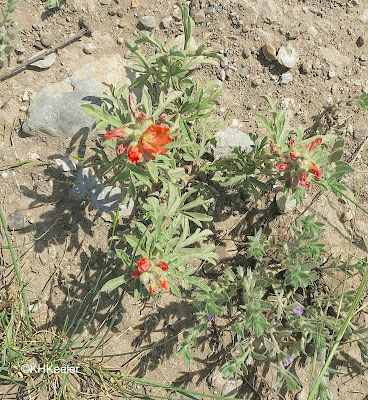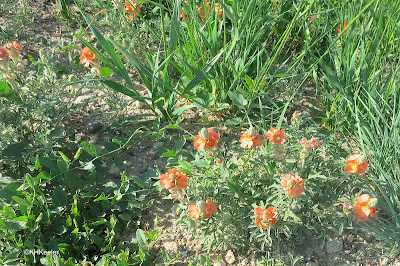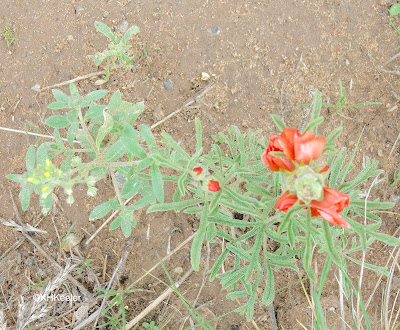Scarlet globemallow, Sphaeralcea coccinea, is a small native mallow of disturbed sites of the western half of the United States and Canada. It has bright orange flowers--nearly red in some areas--and rather gray-green, deeply divided (easily recognized) leaves.
 |
| Scarlet globe mallow, Sphaeralcea coccinea |
With its huge range, it is not surprising that it has several common names, for example cowboy's delight and red false mallow. I've also seen books call it scarlet mallow, orange globe mallow, sore-eye poppy, and grenadine.
The genus Sphaeralcea is found only in the Americas; of the approximately 50 species, 26 grow in the U.S. and Canada. Sphaeralcea coccinea is the only widespread one, ranging from Iowa to Oregon, northern Mexico to Alberta.
 |
| Sphaeralcea coccinea, scarlet globe mallow |
The name Sphaeralcea breaks downt sphaer, meaning sphere, and alcea, Latin for mallow. Sphere and globe refer to the fruits which are round, although rather flat. The species epithet coccinea means red. I would call the flowers I know orange to salmon-colored, but descriptions in plant books sometimes call them brick red and scarlet. In any case the flowers are bright and not a common color.
Mallows (plants in the family Malvaceae) generally are safe to eat, but scarlet globemallow is one that has had traditional uses as medicine rather than as human food. It is grazed by deer, pronghorn, elk, and cattle. It is especially important as forage in drought years because it persists from its large roots after other plants fail. The seeds are eaten by birds and gathered by small mammals. It is the host plant for a variety of native insects across its wide range, including skippers, painted ladies, and noctuids like Tarache major. It is an important part of western food chains.
Like the vegetable okra (Abelmoschus esculentus), which is also in the mallow family, scarlet globemallow is mucillagenous. Native Americans exploited this character, using it as a lotion for skin ailments. Perhaps the most dramatic use of scarlet globemallow was demonstrated by Dakota and Lakota men, who, after chewing it into a paste, rubbed it over their hands and reached calmly into scalding water to, for example, remove cooked meat. Presumably to seal them, the Gosiute rubbed mashed plants over the inner surfaces of earthenware pots. In the Taos Pueblo, mashed scarlet globemallow was mixed with mud to form a very hard, durable floor. At Picuris Pueblo, roots were pounded to a pulp with a water and spread on a fracture to dry as a hard cast. You could also put them into your shoes to soothe and protect blistered feet (not clear who reported this.) The mucillage was very handy.
The leaves are covered with long hairs (trichomes) that, from a distance, provide a pale or grayish tint to the leaves. Plant hairs often help regulate temperature; these may keep the leaves slightly cooler in the strong sunlight of open areas in the West.
Scarlet globemallow's trichomes featured in a lawsuit over an airplane crash. The twin-engine Beechcraft crashed in New Mexico on December 2, 1989, killing both the pilot and the passenger, his wife. Their heirs sued Beechcraft the airplane manufacturer, Pratt and Whitney which made the engines, and AlliedSignal Inc. that supplied the fuel control units. They claimed that plant gunk, found in the engines and the tubes leading to them, was sucked into the plane, blocking the engine and causing the crash. A series of botanists for the defense and for the prosecution inspected the material in the engine and found, especially, the easily-recognized, star-shaped trichomes of Sphaeralcea coccinea. They noted that scarlet globemallow was abundant around the hangar where the wrecked plane was stored and not at the crash site, because the crash site was grazed and cattle like scarlet globemallow. In addition, they burned scarlet globemallow, trying to reach the temperatures in excess of 593o C (1,099oF) of the engine; the plants became charred, distorted and brittle at 315oC, so would have burned up had they been in the plane at the time of the crash. Finally, the crash was in a December snowstorm; pieces of plant were unlikely to have been blowing in the air. Scarlet globemallow's trichomes (and the other bits of plant material) were exonerated from the charge that they were sucked out of the air into the plane's engine and caused the crash.
The whole plant was steeped to make a soothing tea, and a tonic to improve appetite among the Navajo. This tea was also used to treat diseases caused by witchcraft.
Claims that the name "sore-eye poppy" meant it was used to treat sore eyes is disputed by Dunmire and Thierry; they believe that children, having handled or eaten scarlet globemallow, rubbed their eyes with hands covered in the star-shaped trichomes, irritating their eyes. Likewise, the use of them at the Santa Clara Pueblo to rub on sore muscles likely works because irritation from the hairs increases blood circulation in the area. I haven't handled scarlet globemallow a lot, but I've never noticed the hairs, as I have when picking okra. Still, be aware they could be irritating.
 |
| scarlet globemallow, Sphaeralcea coccinea |
This is beautiful, hardy little native, flowering abundantly and surviving on poor sites all across the West. Watch for it.
Comments and corrections welcome.
References
Bates, D.M., G. J. Anderson, and R. D. Lee. 1997. Forensic Botany: Trichome evidence. Journal of Forensic Sciences. 42 (3): 380-386.
Brunk, S.K. 1997. The Ruidoso Plane Crash--Background and the Trial Verdict. Journal of Forensic Sciences. 42 (3): 378-3779.
Dunmire, W.W. and G. D. Tierney. 1995. Wild Plants of the Pueblo Province. Museum of New Mexico Press. Santa Fe, New Mexico.
Farrar, J. 2012. Field Guide to the Wildflowers of Nebraska and the Great Plains. 2nd ed. University of Iowa Press. Iowa City, Iowa.
Kindscher, K. 1992. Medicinal Wild Plants of the Prairie. University Press of Kansas. Lawrence, Kansas.
Moerman, D.E. 1998. Native American Ethnobotany. Timber Press. Portland, Oregon. (also online http://naeb.brit.org
The Wildflower Center Staff. 202. Sphaeralcea coccinea. Wildflower.org link Accessed 2/23/23.
Kathy Keeler, A Wandering Botanist
More at awanderingbotanist.com
Join me on Facebook: https://www.facebook.com/AWanderingBotanist


No comments:
Post a Comment